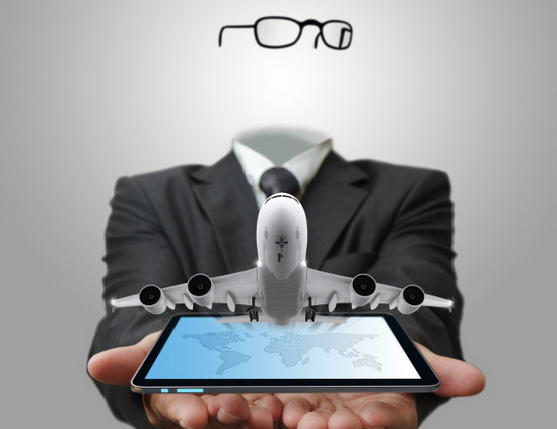In the Guliver blog on Economist.com (Check-in desks Time to check-out?), the writer suggest that airlines do away with airport check-in. We do it all on-line anyway, and who would miss the queues waiting for check-in anyway?. Well, for the most part, self-check-in is common, but not universal (59% of people still check-in at the counter). Airlines have moved automation onto devices, and when it is inside of the airport, it is further and further from the people behind the counter, because check-in stations are not on curbs, right inside the door and arranged like obstacle courses so you have to navigate through them to get to a customer service representative.
I think Guliver is asking the wrong question. What should be asked is can we improve the customer service experience? This image above suggests that airlines think about moving people from the counter to the floor. Between e-printers and tablets, roaming agents could engage more people, and they could do so in the few remaining queues, like bag check-in (still necessary even if on-line bag tags are available). Lines have meaning. Someone a line needs something that they couldn’t get through other means, or, as in my case, after millions of miles, I actually like and appreciate a little human interaction even if it isn’t necessary. I want someone to thank me for my business that isn’t glowing or otherwise highly automated.
Now, according to the J.D. Power 2014 North America Airline Satisfaction Study released back in May, airlines are improving their customer service perceptions (but they still fall behind hotels and rental cars , as well as many other industries, including credit card and mortgage lenders according to the report.) I think they can do better.
Here are a couple of airport check-in go-dos for airlines
- First, airlines can be more active in customer service rather than passive, which means getting out into the lines and the wandering among passengers and setting the expectation that anyone with a tablet and the right jacket can help them. Sure, you may end up with lines in front of customer service representatives in random places, but that kind of dynamic isn’t usual in an airport. And besides, that is another line another agent can intervene with. Just say to the person waiting for the agent, “Come with me, and I will take care of you.”
- Second, airlines need to create a better blended work experience for agents. With Management by Design I focused on how to create great work experiences. I don’t know what the back offices at the airports look like for front counter agents, but I do know that I watch them jumping over luggage belts, sitting in sometimes messy, and often, to me, apparently uncomfortable arrangements, or being on their feet on hard floors. I think airports and airlines could co-create better environments for the agents, that would then bleed over into the customer experience (carpet and padding, new types of engagement areas — why, for instance, should a large family with kids be forced to stand out in the open for 20-or-30 minutes while the agent finds them a new route home from a canceled flight. Wouldn’t private areas be better perhaps? Serve water and have toys available? And how about a concierge experience for the top flyers that includes curb-side bag check (by a person with no fee or tip required) and a little more recognition than getting to wait in shorter lines sooner.
The Landing Strip
As we do more self-service we actually end up with more self-work and self-tasking, not service. Systems manage transactions, while it is people who manage relationships and provide service to others. If airlines want to go up the customer satisfaction scale they need to stop thinking like manufacturing engineers trying to eek out the last bit of performance from the Flight Experience Machine that starts with buying a ticket and ends with luggage pick-up. All of the touch-points along the way now cost something to engage (bags, meals, entertainment, WiFi, etc.). The least airlines can do it provide free smiles, advice and service to those traveling through their Flight Experience Machine from people already employed to do so. Redeploy agents to be ambassadors and concierge staff, empower them to make people happy where they are (deliver satisfaction, don’t make people look for it), and I bet you’ll find those customer service numbers getting closer to the heights enjoyed by other industries.


